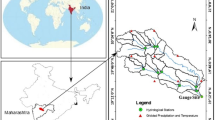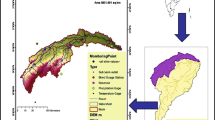Abstract
The Soil Water Assessment Tool (SWAT) was applied to the 2,530 km2 Chaliyar river basin in Kerala, India to investigate the influence of scale on the model parameters. The study was carried out in this river basin at two scales. Parameters such as land use, soil type, topography and management practices are similar at these scales. The model was initially calibrated for streamflow and then validated. Critical parameters were the curve number (CN2), soil evaporation compensation factor (ESCO), available water holding capacity (SOL_AWC), average slope length (SLSUBBSN), and base flow alpha factor (ALPHA_BF). Using the optimized value of various parameters, stream flow was estimated from parts of the basin at two different scales—an area of 2,361.58 km2 and an area of 1,013.15 km2. The streamflow estimates at both these scales were statistically analysed by computing the coefficient of determination (R 2) and the Nash–Sutcliffe efficiency (ENS). Results indicate that the SWAT model could simulate streamflow at both scales reasonably well with very little difference between the observed and computed values. However, the results also indicate that there may be greater uncertainty in SWAT streamflow estimates as the size of the watershed increases.
Similar content being viewed by others
References
Abdulla FA, Lettenmaier DP, Wood EF, Smith JA (1996) Application of a macroscale hydrologic model to estimate the water balance for the Arkansas-Red River basin. J Geophys Res 101-D3:7449–7459
Angelidis P, Kotsikas M, Kotsovinos N (2010) Management of upstream dams and flood protection of the transboundary river Evros/Maritza. Water Resour Manage. doi:10.1007/s11269-009-9563-6
Arnold JG, Srinivasan R, Muttiah RR, Williams JR (1998) Large area hydrologic modeling and assessment. Part I: model development. J Am Water Resour Assoc 34(1):73–89
Cao W, Bowden BW, Davie T (2006) Multi-variable and multi-site calibration and validation of SWAT in a large mountainous catchment with high spatial variability. Hydrol Process 20:1057–1073
Cao W, Bowden WB, Davie T, Fenemor A (2008) Modelling impacts of land cover change on critical water resources in the Motueka river catchment, New Zealand. Water Resour Manage 23:137–151
Di Luzio M, Srinivasan R, Arnold J, Neitsch SL (2002) ArcView interface for SWAT 2000 user’s guide. Blackland Research Center, Texas Agricultural Experiment Station, Temple, Texas, USA
Jha M, Arnold JG, Gassman PW, Giorgi F, Gu R (2006) Climate change sensitivity assessment on upper Mississippi river basin steamflows using SWAT. J Am Water Resour Assoc 42(4):997–1015
Keshta N, Elshorbagy A, Carey S (2009) A generic system dynamics model for simulating and evaluating the hydrological performance of reconstructed watersheds. Hydrol Earth Syst Sci 13:865–881
Legesse D, Christine VC, Gasse F (2003) Hydrological response of a catchment to climate and land use changes in Tropical Africa: case study South Central Ethiopia. J Hydrol 275:67–85
Lobmeyr M, Lohmann D, Ruhe C (1999) An application of a large scale conceptual hydrological model over the Elbe region. Hydrol Earth Syst Sci 3(3):363–374
Mengelkamp HT, Warrach K, Ruhe C, Raschke E (2001) Simulation of runoff and streamflow on local and regional scales. Meteorol Atmos Phys 76:107–117
Mishra A, Kar S, Singh VP (2007) Prioritizing structural management by quantifying the effect of land use and land cover on watershed runoff and sediment yield. Water Resour Manage 21:1899–1913
Nash JE, Sutcliffe JV (1970) River flow forecasting through conceptual models. Part 1: a discussion of principles. J Hydrol 10(3):282–290
Santhi C, Arnold JG, Williams JR, Dugas WA, Srinivasan R, Hauck LM (2001) Validation of the SWAT model on a large river basin with point and nonpoint sources. J Am Water Resour Assoc 37(5):1169–1188
Schuol J, Abbaspour KC (2007) Using monthly weather statistics to generate daily data in a SWAT model application to West Africa. Ecol Model 201:301–311
Spruill CA, Workman SR, Taraba JL (2000) Simulation of daily and monthly stream discharge from small watersheds using the SWAT model. Trans ASAE 43(6):1431–1439
Srinivasan R, Ramanarayanan TS, Arnold JG, Bednarz ST (1998) Large area hydrologic modeling and assessment part II: model application. J Am Water Resour Assoc 34(1):91–101
Sullivan CA, Meigh J (2007) Integration of the biophysical and social sciences using an indicator approach: addressing water problems at different scales. Water Resour Manage 21:111–128
Talebizadeh M, Morid S, Ayyoubzadeh SA, Ghasemzadeh M (2009) Uncertainty analysis in sediment load modeling using ANN and SWAT model. Water Resour Manage. doi:10.1007/s11269-009-9522-2
Author information
Authors and Affiliations
Corresponding author
Rights and permissions
About this article
Cite this article
Thampi, S.G., Raneesh, K.Y. & Surya, T.V. Influence of Scale on SWAT Model Calibration for Streamflow in a River Basin in the Humid Tropics. Water Resour Manage 24, 4567–4578 (2010). https://doi.org/10.1007/s11269-010-9676-y
Received:
Accepted:
Published:
Issue Date:
DOI: https://doi.org/10.1007/s11269-010-9676-y




